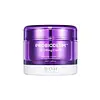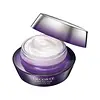What's inside
What's inside
 Key Ingredients
Key Ingredients

 Benefits
Benefits

 Concerns
Concerns

 Ingredients Side-by-side
Ingredients Side-by-side

Water
Skin ConditioningLactobacillus Ferment Lysate
Skin ConditioningGlycerin
HumectantDipropylene Glycol
HumectantCaprylic/Capric Triglyceride
MaskingCetearyl Alcohol
EmollientLimnanthes Alba Seed Oil
Skin ConditioningGlycereth-26
HumectantVinyldimethicone
Hydrogenated Poly(C6-14 Olefin)
EmollientHydrogenated Polydecene
EmollientPolyglyceryl-3 Methylglucose Distearate
EmulsifyingGlyceryl Stearate
EmollientBetaine
HumectantPolyglycerin-3
Humectant1,2-Hexanediol
Skin ConditioningCetearyl Olivate
Pentylene Glycol
Skin ConditioningPhytosteryl/Behenyl/Octyldodecyl Lauroyl Glutamate
Skin ConditioningLactobacillus Ferment
Skin ConditioningFructooligosaccharides
HumectantFructan
Skin ConditioningInulin
Skin ConditioningPanthenol
Skin ConditioningBeta-Glucan
Skin ConditioningAdenosine
Skin ConditioningSaponins
CleansingSoluble Proteoglycan
Skin ConditioningNonapeptide-1
Skin ConditioningAcetyl Tetrapeptide-9
Skin ConditioningAcetyl Tetrapeptide-5
HumectantAcetyl Hexapeptide-1
Skin ConditioningAcetyl Hexapeptide-8
HumectantPalmitoyl Tripeptide-8
Skin ConditioningDipeptide Diaminobutyroyl Benzylamide Diacetate
Skin ConditioningCopper Tripeptide-1
Skin ConditioningTripeptide-1
Skin ConditioningPalmitoyl Tetrapeptide-7
Skin ConditioningPalmitoyl Tripeptide-1
Skin ConditioningPalmitoyl Tripeptide-5
Skin ConditioningPalmitoyl Pentapeptide-4
Skin ConditioningPalmitoyl Hexapeptide-12
Skin ConditioningPentapeptide-3
Skin ConditioningHexapeptide-9
Skin ConditioningOligopeptide-2
Skin ConditioningMalt Extract
Skin ProtectingDioscorea Japonica Root Extract
Skin ConditioningElaeis Guineensis Oil
EmollientBehenyl Alcohol
EmollientSorbitan Olivate
EmulsifyingButyrospermum Parkii Butter
Skin ConditioningDipentaerythrityl Hexahydroxystearate/Hexastearate/Hexarosinate
Skin ConditioningHydrogenated Rapeseed Oil
EmollientHydroxyacetophenone
AntioxidantSodium Polyacrylate
AbsorbentHydrolyzed Jojoba Esters
Skin ConditioningPEG-100 Stearate
Ethylhexylglycerin
Skin ConditioningAcrylates/C10-30 Alkyl Acrylate Crosspolymer
Emulsion StabilisingXanthan Gum
EmulsifyingTromethamine
BufferingButylene Glycol
HumectantMaltodextrin
AbsorbentCyanocobalamin
Skin ConditioningCetyl Ethylhexanoate
EmollientPropanediol
SolventCetearyl Glucoside
EmulsifyingAlgin
MaskingSodium Stearoyl Glutamate
CleansingTocopherol
AntioxidantBiosaccharide Gum-4
Skin ConditioningMineral Salts
Skin ConditioningHydrolyzed Corn Starch
HumectantSodium Phosphate
BufferingCaprylyl Glycol
EmollientSucrose
HumectantDextran
Disodium Phosphate
BufferingParfum
MaskingWater, Lactobacillus Ferment Lysate, Glycerin, Dipropylene Glycol, Caprylic/Capric Triglyceride, Cetearyl Alcohol, Limnanthes Alba Seed Oil, Glycereth-26, Vinyldimethicone, Hydrogenated Poly(C6-14 Olefin), Hydrogenated Polydecene, Polyglyceryl-3 Methylglucose Distearate, Glyceryl Stearate, Betaine, Polyglycerin-3, 1,2-Hexanediol, Cetearyl Olivate, Pentylene Glycol, Phytosteryl/Behenyl/Octyldodecyl Lauroyl Glutamate, Lactobacillus Ferment, Fructooligosaccharides, Fructan, Inulin, Panthenol, Beta-Glucan, Adenosine, Saponins, Soluble Proteoglycan, Nonapeptide-1, Acetyl Tetrapeptide-9, Acetyl Tetrapeptide-5, Acetyl Hexapeptide-1, Acetyl Hexapeptide-8, Palmitoyl Tripeptide-8, Dipeptide Diaminobutyroyl Benzylamide Diacetate, Copper Tripeptide-1, Tripeptide-1, Palmitoyl Tetrapeptide-7, Palmitoyl Tripeptide-1, Palmitoyl Tripeptide-5, Palmitoyl Pentapeptide-4, Palmitoyl Hexapeptide-12, Pentapeptide-3, Hexapeptide-9, Oligopeptide-2, Malt Extract, Dioscorea Japonica Root Extract, Elaeis Guineensis Oil, Behenyl Alcohol, Sorbitan Olivate, Butyrospermum Parkii Butter, Dipentaerythrityl Hexahydroxystearate/Hexastearate/Hexarosinate, Hydrogenated Rapeseed Oil, Hydroxyacetophenone, Sodium Polyacrylate, Hydrolyzed Jojoba Esters, PEG-100 Stearate, Ethylhexylglycerin, Acrylates/C10-30 Alkyl Acrylate Crosspolymer, Xanthan Gum, Tromethamine, Butylene Glycol, Maltodextrin, Cyanocobalamin, Cetyl Ethylhexanoate, Propanediol, Cetearyl Glucoside, Algin, Sodium Stearoyl Glutamate, Tocopherol, Biosaccharide Gum-4, Mineral Salts, Hydrolyzed Corn Starch, Sodium Phosphate, Caprylyl Glycol, Sucrose, Dextran, Disodium Phosphate, Parfum
Water
Skin ConditioningButylene Glycol
HumectantHydrogenated Polydecene
EmollientGlycerin
HumectantLimnanthes Alba Seed Oil
Skin ConditioningHydrogenated Lecithin
EmulsifyingDiphenylsiloxy Phenyl Trimethicone
Skin ConditioningCetearyl Alcohol
EmollientAdenosine
Skin ConditioningArginine
MaskingBetula Platyphylla Japonica Juice
Skin ConditioningCamellia Sinensis Leaf Extract
AntimicrobialDimethylsilanol Hyaluronate
HumectantGlycyrrhiza Glabra Leaf Extract
Skin ConditioningHydroxyproline
Skin ConditioningRhodomyrtus Tomentosa Fruit Extract
HumectantTocopherol
AntioxidantTremella Fuciformis Extract
HumectantVitis Vinifera Fruit Extract
Skin ConditioningBehenyl Alcohol
EmollientCarbomer
Emulsion StabilisingDimethicone
EmollientDisodium EDTA
Disodium Succinate
MaskingEctoin
Skin ConditioningHydrogenated Polyisobutene
EmollientLauryl Polyglyceryl-3 Polydimethylsiloxyethyl Dimethicone
Skin ConditioningPhytosterols
Skin ConditioningPhytosteryl Macadamiate
Skin ConditioningPhytosteryl Oleate
Skin ConditioningPhytosteryl/Behenyl/Octyldodecyl Lauroyl Glutamate
Skin ConditioningPolyglycerin-3
HumectantSodium Hydroxide
BufferingSodium Methyl Stearoyl Taurate
CleansingSuccinic Acid
BufferingXanthan Gum
EmulsifyingPhenoxyethanol
PreservativeParfum
MaskingHexyl Cinnamal
PerfumingLimonene
PerfumingLinalool
PerfumingWater, Butylene Glycol, Hydrogenated Polydecene, Glycerin, Limnanthes Alba Seed Oil, Hydrogenated Lecithin, Diphenylsiloxy Phenyl Trimethicone, Cetearyl Alcohol, Adenosine, Arginine, Betula Platyphylla Japonica Juice, Camellia Sinensis Leaf Extract, Dimethylsilanol Hyaluronate, Glycyrrhiza Glabra Leaf Extract, Hydroxyproline, Rhodomyrtus Tomentosa Fruit Extract, Tocopherol, Tremella Fuciformis Extract, Vitis Vinifera Fruit Extract, Behenyl Alcohol, Carbomer, Dimethicone, Disodium EDTA, Disodium Succinate, Ectoin, Hydrogenated Polyisobutene, Lauryl Polyglyceryl-3 Polydimethylsiloxyethyl Dimethicone, Phytosterols, Phytosteryl Macadamiate, Phytosteryl Oleate, Phytosteryl/Behenyl/Octyldodecyl Lauroyl Glutamate, Polyglycerin-3, Sodium Hydroxide, Sodium Methyl Stearoyl Taurate, Succinic Acid, Xanthan Gum, Phenoxyethanol, Parfum, Hexyl Cinnamal, Limonene, Linalool
 Reviews
Reviews

Ingredients Explained
These ingredients are found in both products.
Ingredients higher up in an ingredient list are typically present in a larger amount.
Adenosine is in every living organism. It is one of four components in nucleic acids that helps store our DNA.
Adenosine has many benefits when used. These benefits include hydrating the skin, smoothing skin, and reducing wrinkles. Once applied, adenosine increases collagen production. It also helps with improving firmness and tissue repair.
Studies have found adenosine may also help with wound healing.
In skincare products, Adenosine is usually derived from yeast.
Learn more about AdenosineBehenyl Alcohol is a type of fatty alcohol (these are different from the drying, solvent alcohols).
Fatty Alcohols have hydrating properties and are most often used as an emollient or to thicken a product. They are usually derived from natural fats and oils; behenyl alcohol is derived from the fats of vegetable oils.
Emollients help keep your skin soft and hydrated by creating a film that traps moisture in.
In 2000, Behenyl Alcohol was approved by the US as medicine to reduce the duration of cold sores.
Learn more about Behenyl AlcoholButylene Glycol (or BG) is used within cosmetic products for a few different reasons:
Overall, Butylene Glycol is a safe and well-rounded ingredient that works well with other ingredients.
Though this ingredient works well with most skin types, some people with sensitive skin may experience a reaction such as allergic rashes, closed comedones, or itchiness.
Learn more about Butylene GlycolCetearyl alcohol is a mixture of two fatty alcohols: cetyl alcohol and stearyl alcohol. It is mainly used as an emulsifier. Emulsifiers help prevent the separation of oils and products. Due to its composition, it can also be used to thicken a product or help create foam.
Cetearyl alcohol is an emollient. Emollients help soothe and hydrate the skin by trapping moisture.
Studies show Cetearyl alcohol is non-toxic and non-irritating. The FDA allows products labeled "alcohol-free" to have fatty alcohols.
This ingredient is usually derived from plant oils such as palm, vegetable, or coconut oils. There is debate on whether this ingredient will cause acne.
Due to the fatty acid base, this ingredient may not be Malassezia folliculitis safe.
Learn more about Cetearyl AlcoholGlycerin is already naturally found in your skin. It helps moisturize and protect your skin.
A study from 2016 found glycerin to be more effective as a humectant than AHAs and hyaluronic acid.
As a humectant, it helps the skin stay hydrated by pulling moisture to your skin. The low molecular weight of glycerin allows it to pull moisture into the deeper layers of your skin.
Hydrated skin improves your skin barrier; Your skin barrier helps protect against irritants and bacteria.
Glycerin has also been found to have antimicrobial and antiviral properties. Due to these properties, glycerin is often used in wound and burn treatments.
In cosmetics, glycerin is usually derived from plants such as soybean or palm. However, it can also be sourced from animals, such as tallow or animal fat.
This ingredient is organic, colorless, odorless, and non-toxic.
Glycerin is the name for this ingredient in American English. British English uses Glycerol/Glycerine.
Learn more about GlycerinHydrogenated Polydecene is an emollient. It creates a non-occlusive film on the skin that offers extra protection for your skin barrier.
The texture of Hydrogenated Polydecene ranges from light and silky to rich.
Hydrogenated Polydecene is the end compound of controlled hydrogenation of Polydecene.
Learn more about Hydrogenated PolydeceneLimnanthes Alba Seed Oil is the oil extracted from the seeds of the meadowfoam plant. This oil is non-fragrant and is an emollient. As an emollient, meadowfoam seed oil helps soften and hydrate the skin.
Meadowfoam seed oil is stable and has a long shelf life due to its chemical structure. It has the highest concentration of stable fatty-acids among plant oils, preventing it from degrading once exposed to oxygen.
Due to the fatty acid content, this ingredient may not be fungal-acne safe.
Meadowfoam is native to California and Oregon.
Learn more about Limnanthes Alba Seed OilParfum is a catch-all term for an ingredient or more that is used to give a scent to products.
Also called "fragrance", this ingredient can be a blend of hundreds of chemicals or plant oils. This means every product with "fragrance" or "parfum" in the ingredients list is a different mixture.
For instance, Habanolide is a proprietary trade name for a specific aroma chemical. When used as a fragrance ingredient in cosmetics, most aroma chemicals fall under the broad labeling category of “FRAGRANCE” or “PARFUM” according to EU and US regulations.
The term 'parfum' or 'fragrance' is not regulated in many countries. In many cases, it is up to the brand to define this term.
For instance, many brands choose to label themselves as "fragrance-free" because they are not using synthetic fragrances. However, their products may still contain ingredients such as essential oils that are considered a fragrance by INCI standards.
One example is Calendula flower extract. Calendula is an essential oil that still imparts a scent or 'fragrance'.
Depending on the blend, the ingredients in the mixture can cause allergies and sensitivities on the skin. Some ingredients that are known EU allergens include linalool and citronellol.
Parfum can also be used to mask or cover an unpleasant scent.
The bottom line is: not all fragrances/parfum/ingredients are created equally. If you are worried about fragrances, we recommend taking a closer look at an ingredient. And of course, we always recommend speaking with a professional.
Learn more about ParfumWe don't have a description for Phytosteryl/Behenyl/Octyldodecyl Lauroyl Glutamate yet.
Polyglycerin-3 is a 3-unit glycerin polymer.
Like glycerin, this ingredient is a humectant. Humectants help hydrate your skin by drawing water to it.
Having moisturized skin helps improve the skin barrier. Your skin barrier helps protect against irritants and bacteria.
Learn more about Polyglycerin-3Tocopherol (also known as Vitamin E) is a common antioxidant used to help protect the skin from free-radicals and strengthen the skin barrier. It's also fat soluble - this means our skin is great at absorbing it.
Vitamin E also helps keep your natural skin lipids healthy. Your lipid skin barrier naturally consists of lipids, ceramides, and fatty acids. Vitamin E offers extra protection for your skin’s lipid barrier, keeping your skin healthy and nourished.
Another benefit is a bit of UV protection. Vitamin E helps reduce the damage caused by UVB rays. (It should not replace your sunscreen). Combining it with Vitamin C can decrease sunburned cells and hyperpigmentation after UV exposure.
You might have noticed Vitamin E + C often paired together. This is because it is great at stabilizing Vitamin C. Using the two together helps increase the effectiveness of both ingredients.
There are often claims that Vitamin E can reduce/prevent scarring, but these claims haven't been confirmed by scientific research.
Learn more about TocopherolWater. It's the most common cosmetic ingredient of all. You'll usually see it at the top of ingredient lists, meaning that it makes up the largest part of the product.
So why is it so popular? Water most often acts as a solvent - this means that it helps dissolve other ingredients into the formulation.
You'll also recognize water as that liquid we all need to stay alive. If you see this, drink a glass of water. Stay hydrated!
Learn more about WaterXanthan gum is used as a stabilizer and thickener within cosmetic products. It helps give products a sticky, thick feeling - preventing them from being too runny.
On the technical side of things, xanthan gum is a polysaccharide - a combination consisting of multiple sugar molecules bonded together.
Xanthan gum is a pretty common and great ingredient. It is a natural, non-toxic, non-irritating ingredient that is also commonly used in food products.
Learn more about Xanthan Gum